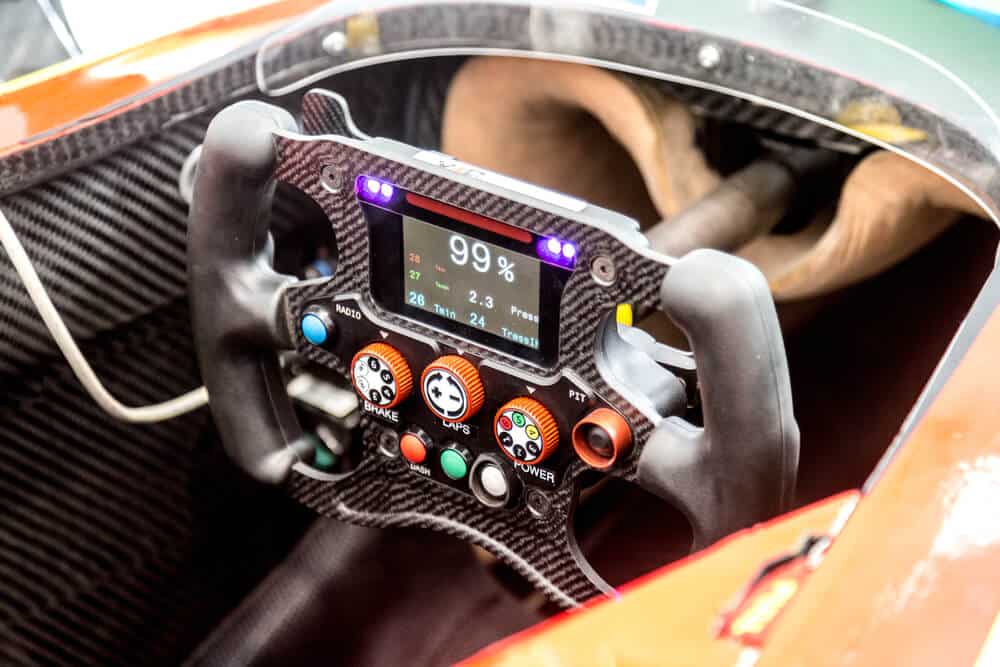F1 car steering wheels are far more complex than the standard steering wheel you find in a regular car. They are designed to provide drivers with a range of functionalities and data, enabling them to make quick decisions on the track.
In the early days of F1 racing, the steering wheels were relatively simple, with only a few buttons to control the car’s gears and throttle. However, with the evolution of technology, steering wheels have become much more sophisticated, featuring advanced functionalities and data analysis capabilities.
Table of Contents
Watch this video to learn more about Mercedes steering wheel.
Key Components of an F1 Car Steering Wheel
F1 car steering wheels are made up of several key components, each designed to provide drivers with specific functionalities. Let’s take a closer look at some of these components:
Display Screen
The display screen is an essential component of an F1 car steering wheel. It provides drivers with critical information such as lap times, fuel levels, and speed. The screen also displays the driver’s position on the track, allowing them to make quick decisions on overtaking or defending their position.
Shift Lights
Shift lights are used to alert drivers when it’s time to change gears. They light up in sequence as the engine approaches its maximum revs, indicating that the driver needs to shift to the next gear. This feature is crucial in F1 racing, where every fraction of a second counts.
Paddle Shifters
Paddle shifters are used to change gears without taking your hands off the steering wheel. These paddles are located behind the steering wheel and can be easily activated with the flick of a finger. They are crucial in F1 racing, where drivers need to change gears quickly and efficiently.
Rotary Switches
Rotary switches are used to adjust various settings on the car, such as brake bias, fuel mixture, and traction control. These switches are designed to be easily accessible, allowing drivers to make quick adjustments during a race.
Push Buttons
Push buttons are used to activate various functionalities on the car, such as the pit limiter, radio communication, and even the drink system. These buttons are strategically placed on the steering wheel for quick access.
DRS Button
The DRS (Drag Reduction System) button is used to activate the car’s aerodynamic system, which reduces drag and increases speed. This feature can only be used in certain sections of the track, making it a crucial component of F1 racing.
Radio Button
The radio button is used to communicate with the pit crew. Drivers can use this button to provide feedback on the car’s performance or request information about the race.
Clutch Paddles
Clutch paddles are used to engage and disengage the clutch, allowing drivers to accelerate or decelerate quickly. These paddles are located on the back of the steering wheel and can be activated with the flick of a finger.
Brake Bias Adjuster
The brake bias adjuster is used to change the balance of the car’s braking system. This feature is crucial in F1 racing, where drivers need to make quick adjustments to optimize the car’s performance.
Multifunction Rotary Dial
The multifunction rotary dial is used to activate various functionalities on the car, such as the pit limiter and fuel mixture. This dial is designed to be easily accessible, allowing drivers to make quick adjustments during a race.
Thumb-Operated Joystick
The thumb-operated joystick is used to control various functionalities on the car, such as the differential and traction control. This feature is designed to be easily accessible, allowing drivers to make quick adjustments during a race.
Customization and Personalization of an F1 Car Steering Wheel
F1 car steering wheels are highly customizable, allowing drivers to tailor them to their preferences and driving styles. Here are some customization options available for F1 car steering wheels:
Button Layout
The button layout can be customized to suit the driver’s preferences. This can include the placement of buttons, the number of buttons, and the functionalities of each button.
Size and Shape
The size and shape of the steering wheel can be customized to suit the driver’s hands and driving style. This can include the diameter of the steering wheel, the shape of the grip, and the angle of the spokes.
Material
The material of the steering wheel can be customized to suit the driver’s preferences. This can include the type of leather, the color of the stitching, and the finish of the metal components.

Steering Wheel Data Analysis
F1 car steering wheels are not just about providing drivers with functionalities. They are also designed to collect data on the car’s performance, allowing teams to make adjustments and improve the car’s performance. Here are some data analysis capabilities of F1 car steering wheels:
Telemetry
Telemetry data is collected from the car and transmitted to the pit crew, allowing them to monitor the car’s performance in real-time. This data includes speed, acceleration, fuel consumption, and tire wear.
Driver Feedback
F1 car steering wheels also collect feedback from the driver, allowing the team to understand how the car is performing from the driver’s perspective. This feedback includes information on the handling, grip, and balance of the car.
Lap Time Analysis
F1 car steering wheels can also analyze lap times, allowing teams to identify areas where the driver can improve their performance. This data can be used to make adjustments to the car and to provide feedback to the driver.
Future of F1 Car Steering Wheels
As technology continues to evolve, we can expect F1 car steering wheels to become even more sophisticated. Here are some future trends to watch out for:
Augmented Reality Displays
Augmented reality displays are expected to be integrated into F1 car steering wheels, providing drivers with even more information on the track. This technology can include 3D maps of the track, real-time data on competitors, and predictive analytics.
Haptic Feedback
Haptic feedback is expected to be integrated into F1 car steering wheels, providing drivers with tactile feedback on the car’s performance. This can include vibrations in the steering wheel to alert drivers to changes in grip or balance.
Biometric Sensors
Biometric sensors are expected to be integrated into F1 car steering wheels, providing teams with data on the driver’s physical condition. This can include information on heart rate, breathing rate, and even stress levels.
Frequently Asked Questions
1. What functionalities does an F1 car steering wheel have?
2. How do F1 drivers customize their steering wheels?
3. What data can be collected from an F1 car steering wheel?
4. Can an F1 car steering wheel be used in other types of racing?
Conclusion
In conclusion, F1 car steering wheels are complex and sophisticated components that play a crucial role in the performance of an F1 car. From key functionalities to customization options and data analysis capabilities, there is much to explore in the world of F1 car steering wheels.
As technology continues to evolve, we can expect even more advanced features to be integrated into these critical components, allowing drivers and teams to perform at their best on the track.
Article sources
Learn more about Formula One
Want to learn more about F1? Then visit our Formula 1 glossary and dictionary.



